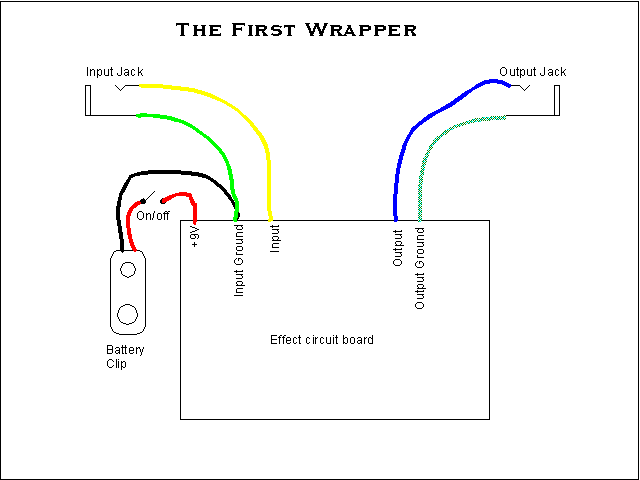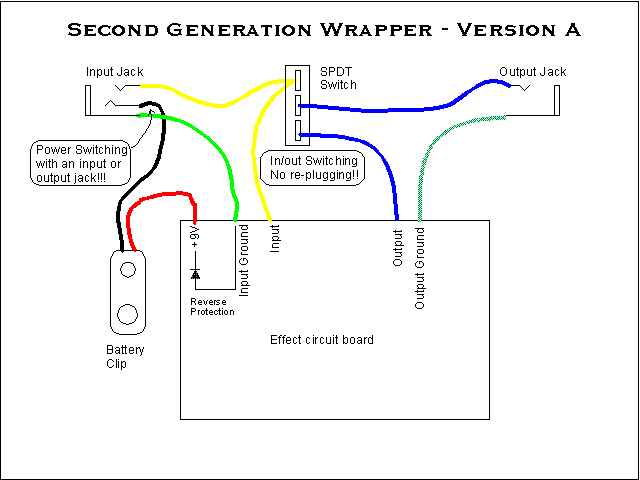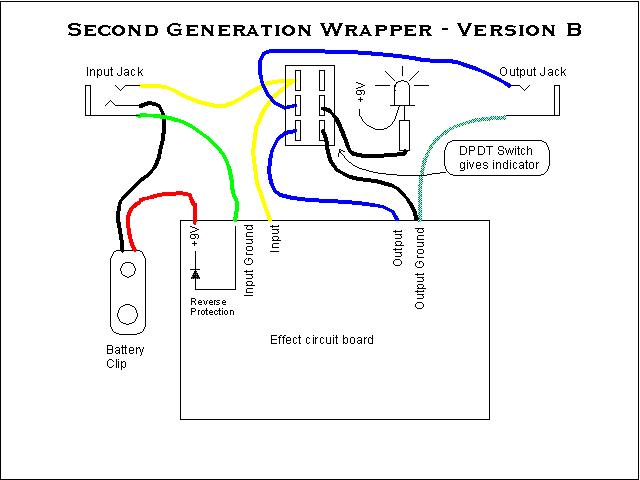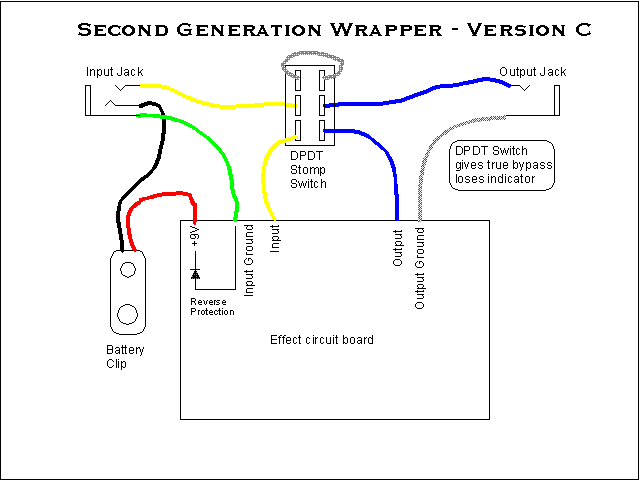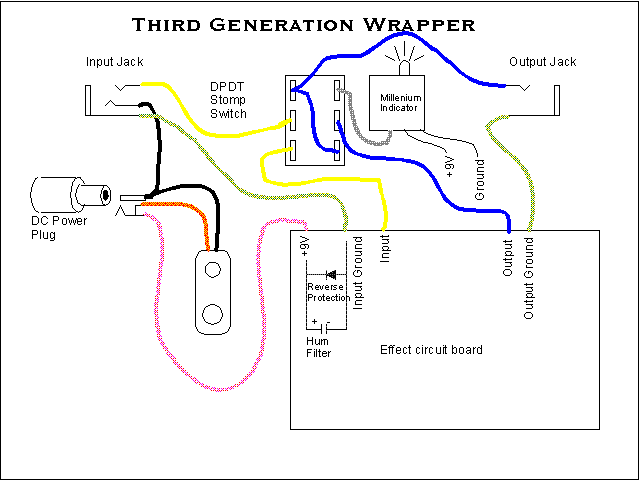About the third time you build an effect, you figure out that there's a lot of manual labor that you're doing wiring this stuff up to the jacks, battery clip and other stuff that's awfully similar to what you did the last time. And you're dead right - there are some things about an effect that may change slightly in appearance, but they do the same job on every effect. I like to think of the effect circuit itself as the active part, the kernel inside the effect shell, and the rest of the junk outside the effect circuit as the "wrapper". I thought it would be fun to look at how wrappers evolved, and where they might go. Here's the first wrapper. There's not much there - just the external box that everything goes in, with two jacks, a power switch and a battery clip connecting to the effect board. The controls on every effect will be different, so I don't really think of those as part of the wrapper, but part of the effect circuit itself. This has the minimum that any effect has to do - you have to be able to get a signal in, get a signal out, support the thing mechanically (the box) and supply power, turning the power off when you don't need it so you don't run the batteries down.
We've all built one like this, just to get a hot new effect to run quickly and it does work. There are even some early commercial effects that were wired almost this simply, the Dallas Rangemaster coming to mind. But it's missing some really, really important things that our modern electronics world has made into necessities. There's no way to bypass the effect without replugging the cords! That led pretty quickly to the second generation. The second generation had a couple of major, major improvements over the first. An effect bypass switch was introduced. About this time, the stereo jack trick for automated power switching was thought up, too, and we started seeing boxes with bypass switches and no power switches. All the early MXR boxes used this kind of wrapper. There is another wrapper feature that got put on the circuit board - the reverse battery protector. The earliest effects were pretty much immune to reversed batteries. There was no obvious damage, even though if repeated this abuse could cause the transistors to get noisy. With the advent of opamps in effects, the opamps could be killed by a reversed battery, so the effect board started including a diode either in series or in shunt with the power supply. This diode prevented the application of reverse voltage. Strictly speaking, it's part of the wrapper.
Musicians are a picky bunch, though. Playing in smoky bars with almost no lights around, they wanted to see where their effects were to switch them in and out, and also get an indication of whether the effect was bypassed or not. This last requirement came about when players accumulated more than one stompbox, and it was not always clear whether the box was in operation or not.
The appliance industry came to the rescue here, with a stomp switch that had more contacts. A double pole, double throw stomp switch let the effect be bypassed and had contacts left over to turn on an LED (which was new technology about the time that this wrapper evolved) so that the status of the effect, bypassed (dark) or not (lighted) could be easily seen. The wiring was only a little bit more complicated than the first "second generation" and this one got a lot of use, later MXR being a good example. At about the same time, some musicians noticed that their tone changed when the effect was plugged in, even when bypassed. As explained in "The Technology of Bypasses", what was happening was that the effect input that was always connected to the guitar signal. The guitar was loaded by the effect circuit, and being highly inductive, had a rapid falloff of treble tones - the instrument sounded muffled just by the effect being plugged up. This led to the invention of the true bypass. This used the same DPDT stomp switch that the version B wrapper did, but used the extra switching contacts to manipulate the signal path to completely disconnect the guitar signal from the effect when in bypass, so there was no tone degradation. Version C shows this typical wiring.
Versions B and C persisted side by side for a long time - say, the 70's through the 90's. The reason for this long coexistance in spite of the obvious need to combine the LED switching of Version B and the true bypass switching of version C. The only reason this didn't get resolved was that there wasn't another industry that provided a ready-made stomp switch to do this. The requisite switch - a triple pole double throw switch - existed for some reasonably esoteric electronic functions, but the available units were neither as tough in the face of stomping nor as affordable. In the mean time, another addition to the wrapper came up. The growing number of effects on guitarist's pedalboards caused another problem to arise, though. 9V batteries cost from $1 to $3, and a pedalboard with ten pedals ate a lot of them. Sheer economic necessity forced the DC power jack to be added to the wrapper. This was pretty simple, just a DC power connector that disconnected the internal battery when a DC power plug was inserted. As long as the DC power was compatible with the effect board, this worked great. However, there are a lot of DC power adapters with miserable performance. Some of them make DC OK, but with no filtering whatsoever. These make effects hum like a beehive. This one thing drove the insertion of large capacitors to filter power onto the effect board itself. This is another component like the reverse-protection diode that is strictly speaking a part of the wrapper, but gets included on the effect board. The best solution, however, was to use a good, filtered, regulated DC power pack. In the 90's, we finally got a solution to the pesky problem of having to choose either a DPDT true bypass with no status indicator, a status indicator with no true bypass and a DPDT, or an expensive and often delicate 3PDT stomp switch to get both true bypass and an indicator LED. (For a more complete rundown on how this came about, read The Techonology of Bypasses.) Rearranging the contacts on the DPDT switch left a single switch contact open, and this could be used to connect the input or output of the effect to some external circuit. The first of these circuits used ordinary bipolar transistors to switch an LED on and off. These circuits all suffered to some degree from either requiring a very low output resistor on the effect or causing clicks when the effect was switched. The invention of the Millenium Bypass, which uses JFET or MOSFET switch devices and the leakage of a signal diode to bias them solved the inherent problems of the bipolar indicator driver. With the Millenium Bypass, the third generation of wrapper was complete.
The evolution of wrappers is by no means complete. If you think about it, the whole purpose of a wrapper is to make the world safe for the effect circuit to operate without impinging on the audible operation of the effect. It's a kind of protective shell. Modern complex pedalboards and more complicated effects keep creating new demands. For example, many effects are finding that the single 9V battery is a confining restriction, and the large number of effects and cords combined with AC powered external DC supplies are making ground induced hum a problem. Solutions to these two problems are shown below. The power problem is solved by adding some kind of power converter to the effect itself to make whatever power is required out of 9Vdc, but this causes problems with the stereo jack power switch. Using a single bipolar transistor to switch the power instead of the input jack itself sidesteps the problem. Hum on pedalboards can come from ground loop pickup. For the cost of a single opamp, you can get rid of most forms of hum by driving the output jack "ground" terminal with the difference between the input ground and the average ground signal on the output jack. This circuit would eliminate hum loop pickup on boards if applied to all effects. 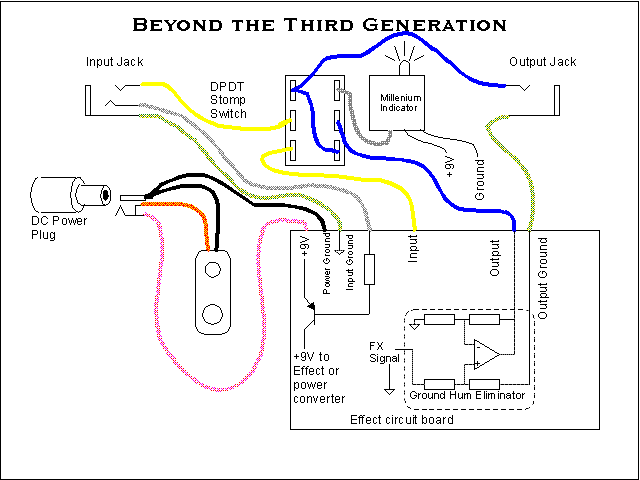 The development of wrappers will keep going. It's useful to think of how these things make the world safe for our effects. |
